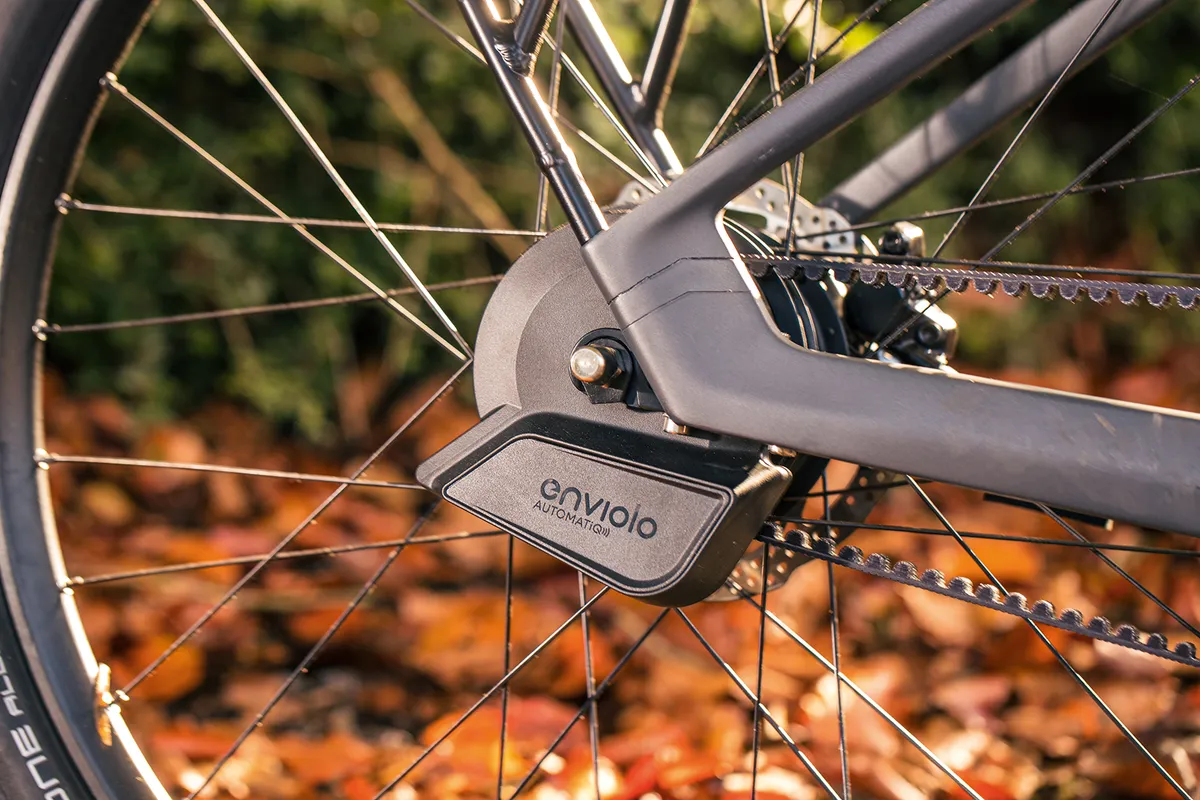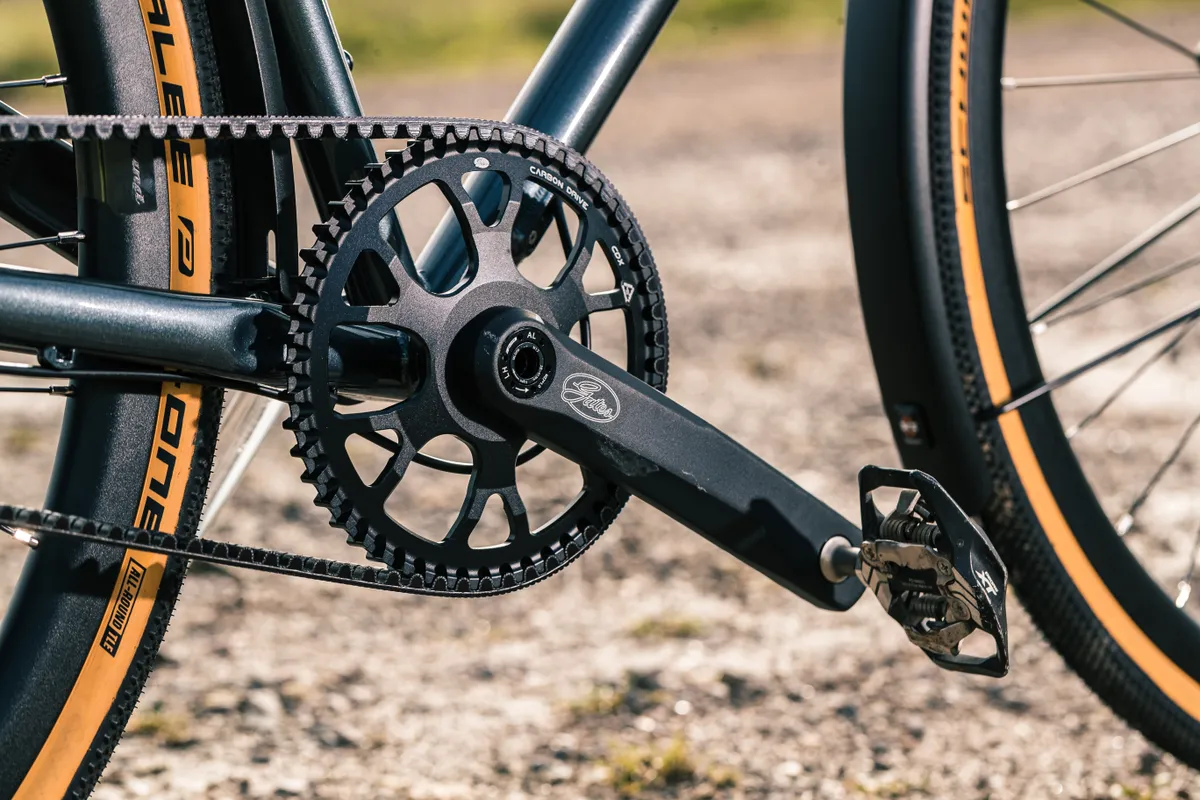A belt drive is an alternative to the conventional bike chain. They have several advantages, particularly for riders who don’t have the time or inclination to keep a chain maintained.
Chains require regular cleaning and lubrication to keep them running smoothly and stop them from rusting. They are also messy and need regular replacement due to wear and stretch.
In contrast, a belt drive has lower maintenance requirements and isn’t greasy, so you’re much less likely to make a mess of your clothing.
The Gates Belt Drive is the best-known belt drive system for bicycles, but there are alternatives.
Here, we’ll explain what a belt drive for a bike is, how they works and the pros and cons of belt drives. We’ll look at the options available, their use in electric bikes, and discuss whether a belt drive bike is a good alternative to a chain drive for your riding.
How do belt drive bicycles work?

A belt drive replaces the usual bicycle chain with a toothed belt. This accomplishes the same job as a chain, connecting the crankset to the rear wheel to drive.
A metal-toothed drive/cog – analogous to a conventional chainring – fits to a standard crankset, over which the belt runs. This connects to a single metal sprocket at the rear, again with teeth.
The belt’s teeth are made of plastic and the belt is reinforced with carbon fibres to prevent it from stretching.
Most belts are continuous, to preserve their strength, but splittable belts that join with a rivet are available.
A belt drive bike’s belt tension needs to be correct for the drivetrain to work at its best, and to avoid wear.
What are the pros and cons of belt drive bicycles?

Pros of belt drives
- Low maintenance: Bicycle belt drives are essentially maintenance-free. They don’t rust, need cleaning or stretch. They still require cleaning to remove accumulated gunk but this is much easier than cleaning a chain
- Longer lasting: A belt drive will usually last longer than a chain. Tern Bikes suggests a belt drive can last up to 40,000km. In contrast, chains stretch and generally need replacing every 5,000km or so to keep your drivetrain running properly
- Clean: No lubricant means that belt drives are clean. There’s no risk of getting bike oil and muck on your clothes, making belt drives a useful option for commuters and casual riders in particular.
- Fewer sharp edges: Chainrings and sprockets on chain drive bikes are sharp, as you’ll know if you’ve ever bashed your leg on them. In contrast, the tooth profiles of a belt drive are much smoother, so you’re less likely to gouge yourself when handling your bike
- Lightweight: A carbon belt is significantly lighter than a metal chain – a belt drive is up to three times lighter than a chain drive. Canyon claims a carbon belt weighs 87g versus 300g for a metal chain
- Quiet: If set up well and clean, a belt drive can be quieter than a chain
Cons of belt drives
- More expensive: Bikes fitted with a belt drive are generally more expensive. While common in other industries, belts are a niche option in cycling, so components command a higher price
- Higher system weight: Belt drive bikes with multiple gear ratios generally use a gear hub. Hub gears are typically heavier than derailleur gears. The Pinion crankset gearbox is another option to provide multiple gears with a belt drive, but again it’s heavier than a derailleur system
- Extra friction: A chain is very efficient if maintained and lubricated. There’s greater friction between the wider teeth in the belt and the gear wheels in a belt drive
- Tricky setup: As with the chain on a single-speed chain-driven bike, the belt needs to be tensioned correctly to keep it running smoothly without skipping
- Precise alignment: The belt needs to be well aligned along its length. Misalignment may increase wear on the belt and the risk of skipping or derailing
- Harder to obtain parts: While every bike shop will sell you a chain, you might find it harder to obtain replacement parts for a belt drive, so if your drivetrain does need fixing your bike may be off the road for longer
- Not fixable on the road: A reasonably handy mechanic can fix a damaged bike chain while out riding, provided they have the right tools (which themselves add to the overall weight to move around). A damaged belt isn’t fixable by the user and requires replacement
- Hardtails only: Almost all full-suspension systems have a pivot that alters the distance between the bottom bracket and the rear hub as it compresses. In a chain-driven bike, the derailleur or a chain tensioner takes up the slack and keeps the chain under tension. There are, of course, exceptions – a few full-suspension belt drive MTBs use a tensioner to keep the belt taut
- Less efficient at high power: A chain is more efficient than a belt under high power outputs, making it a better solution for racing bikes, mountain bikes and high-torque electric bikes, such as eMTBs
- Specific frame requirements: While a replacement chain is joined after it is threaded through the derailleurs and the rear triangle, most belts are continuous. This means the frame needs to be designed so the rear triangle can be separated to mount the belt. The alternative is an open rear frame, as in the MiRider One electric bike. So you can’t retrofit most belt drives to a frame designed for a chain
- More stress on bearings and axles: The need for a higher tension in most belt drives means the crankset and rear wheel bearings are under greater stress, so they may be subject to faster wear
Despite the rather long list of cons, many of these will have been addressed by the bike maker in designing their belt drive bikes. The appeal of low maintenance is likely to be the most significant buying actor for riders considering a belt drive bicycle.
What types of belt drive are there?

The Gates Belt Drive is the most popular belt drive system.
This uses a toothed belt reinforced with carbon fibres, which run along its length. This engages with a toothed single chainring and a toothed single sprocket at the rear wheel.
Gates has four different belt drive systems, designed for different uses from high-output MTB and eMTB use through to a cheaper system for entry-level bikes. All use continuous belts and so need a bike frame specifically designed for belt drive use.

Veer is one of Gates' biggest competitors. Alongside continuous belt systems, it offers a split belt which can be rejoined with a metal rivet much like those in a chain. This means it can be used with a standard bike frame without a split rear triangle.
Veer says its belts require lower tension than Gates, so there’s less fettling required to keep them running properly.
What about belt drives on electric bikes?

Belt drives are a popular option on electric bikes, particularly city hybrid ebikes.
They add to the ebike’s practicality and the motor assistance means that you have to worry less about the lower drivetrain efficiency than with a person-powered bike.
Not all belt drive systems can reliably handle the additional power output of an electric bike, but both Gates and Veer have products designed for ebike use.
So, should you get a belt drive bike?
Despite the long list of cons for a belt drive above, belt drives are a compelling alternative to chain-driven bikes, and are among the best bikes for commuting and city riding.
The low maintenance, no grease design is ideal for a bike which you might want to ride in civilian clothing. Bike manufacturers will have designed their belt-driven bikes to eliminate many of the negatives above, such as misalignment.
Paired with a suitable internal gear hub – such as those from Rolhoff – a belt drive is also a good option for long-distance touring bikes, due to the low maintenance requirements. However, if something does go wrong, getting it fixed may be a problem.
On the other hand, if you don’t mind the regular cleaning and fettling required to keep a chain running well and have the tools for the job, a chain-driven bike is still likely to be more efficient and a multi-speed bike lighter than an equivalent belt-driven bike.
A chain-driven bike is still likely to be the best option for you if you’re into performance road, gravel or mountain bike riding.

